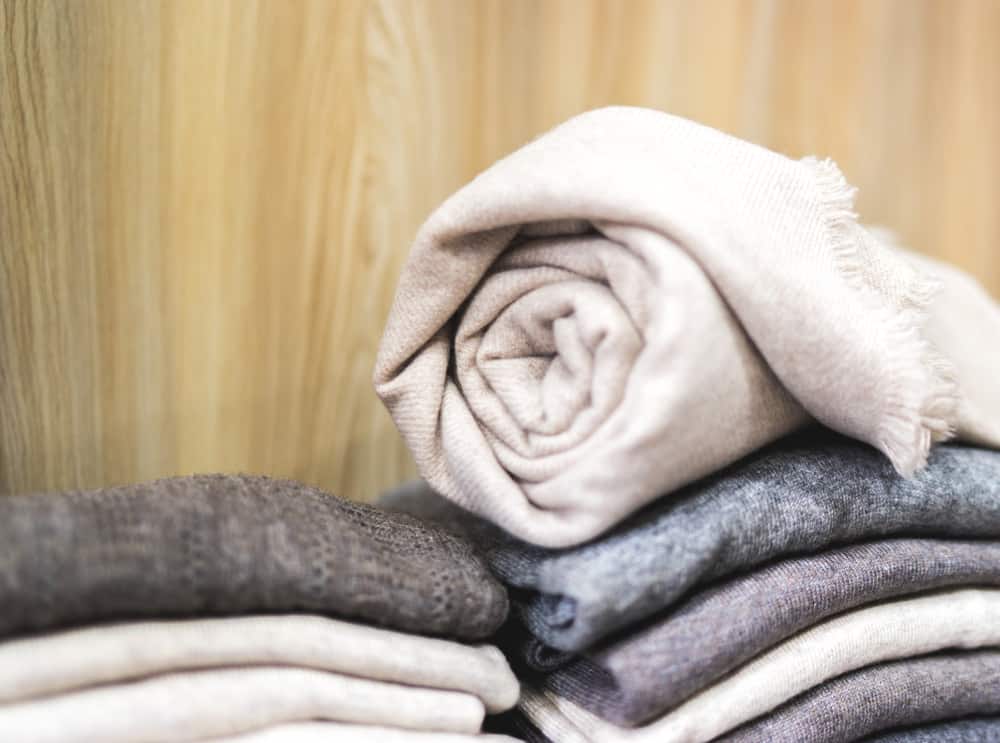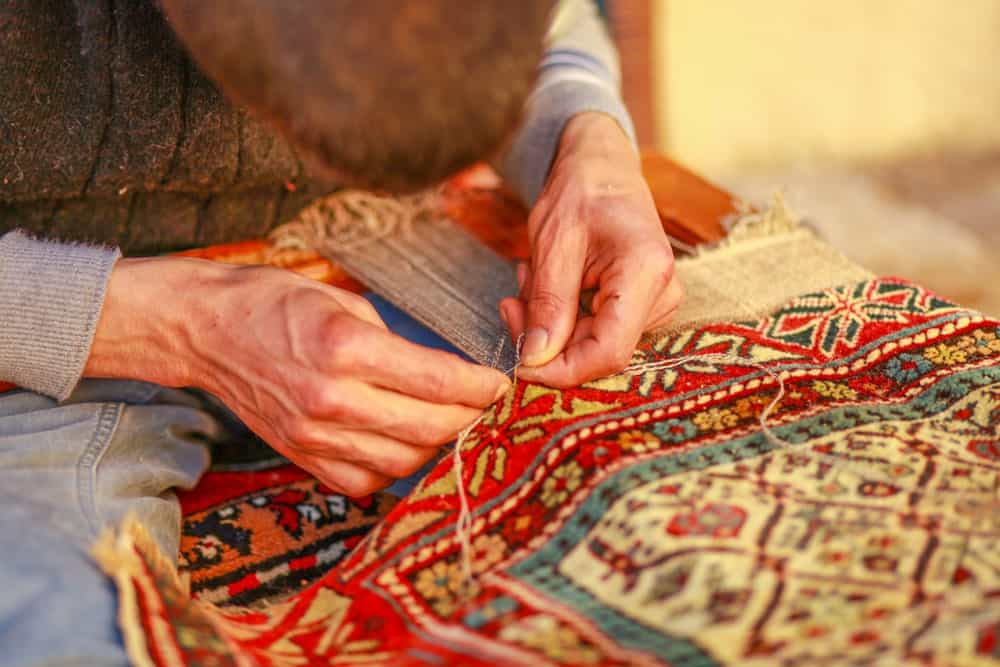Cashmere clothing is a luxury item that is warm, soft, and simply irresistible. However, due to the soft nature of the natural fibers storing cashmere can be tricky. Always lay cashmere clothing flat in a cool and dry place to keep your clothing lasting great for to come.

Cashmere is a luxury item that is soft, warm, and wonderful to own. Cashmere knitwear, though, can be delicate, so protecting your garment is a top priority. When it comes to a cashmere garment, there are several precautions to take to ensure your sweater or cashmere scarf continues to look good for years to come.
Below, let’s take a look at some suggestions to keep your cashmere looking great, even when storing your sweater year after year.
Table of Contents
Never Hang

Whether you have a cashmere dress, sweater, or scarf, you never want to hang your cashmere clothes. Cashmere, although light and soft, is a heavier material that can change shape very quickly. Leaving a dress or a sweater on a hanger can cause the delicate cashmere fibre to stretch. When the fibres stretch, it can cause your garment to lose its original shape. Long term, this can make your cashmere items look distorted or cause your items not to fit as well as they once did.
Instead, it is a good practice always to fold your cashmere garments. Be sure to place your cashmere dress or sweater in a drawer or on a shelf lying flat. If the cashmere item is simply folded and resting, it will not lose its shape. This practice will keep your cashmere sweater or dress looking great for years to come.
Limited Plastic

Although space-saving plastic bins and containers are a great way to pack away your seasonal items, like a cashmere sweater, it is not a good idea to leave your cashmere in plastic for an extended period. Garment experts suggest only leaving cashmere in plastic for about three months. This practice holds true for items placed in a plastic bin or a plastic bag.
Plastic tends to trap moisture and heat, which can damage the sensitive cashmere fibers. Too much-trapped moisture can cause mold or mildew to grow inside the natural cashmere fibers. Too much mold and mildew can discolor or stain your garment, give your garment an odor, or permanently damage the integrity of your sweater.
Use Cedar Balls

Moths are naturally attracted to natural fibers like wool. Cashmere is particularly susceptible to moth damage. To help prevent damage to wool sweaters, try adding cedar wood balls to your drawers and shelves. The cedar ball has a strong yet pleasant smell that can deter moths from making a home in your dresser. When you work to repel the moths, you can eliminate damage caused by this hungry insect.
Controlled Climate

To protect your cashmere year-round, be sure to keep your garments in a controlled environment. Leaving your delicate cashmere piece in a hot or humid area can cause moisture to work itself into the thin fibers. When there is moisture in your cashmere, it can quickly grow mold and mildew. Too much mold and mildew can severely damage your sweater, which can be irreversible.
Gentle Detergent

Before storing your cashmere away for the season, make sure your sweater is clean. The best option to clean cashmere is to use a professional dry cleaning service. If dry cleaning isn’t available, it is still possible to use a gentle detergent to wash your clothing. Always use a mild detergent or one that is intended for wool sweaters.
Use cool water or lukewarm water so that you do not damage or shrink the cashmere. To dry, make sure you leave your cashmere flat on a clean, light-colored towel. You never want to dry your cashmere in the dryer or hang it to dry. Once the sweater is fully dry, you will be able to pack your sweater away for the season.
FAQs

When you pay for expensive cashmere clothing, it makes sense to protect your investment for as long as possible. Storing your cashmere correctly is a great way to keep your cashmere item looking great for years to come. Of course, many people have questions surrounding how to store their favorite cashmere sweater, so we have put together a list of frequently asked questions about how to store cashmere so you can better protect your clothing.
Why does proper storage matter for cashmere?
Cashmere is a costly, luxury item that must be appropriately cared for. Due to the delicate nature of the cashmere wool, it can become easily damaged if the fiber is stretched or exposed to harsh conditions. Taking the proper precautions by implementing proper storage techniques can make your expensive, luxury cashmere items last for years.
Can you fix holes in cashmere?
It can be challenging to fix holes in cashmere, but it is possible. Most cashmere items are woven together by looping the delicate cashmere fibers through one another. If a small hole develops, it may be possible to stitch the areas that have become separated carefully.
A professional sewist may even be able to use a matching cashmere thread to create a seamless patch. Although the sweater will never be 100% perfect and like new, many professional cashmere stitching and patches will go completely unnoticed.
How do you store cashmere at home?
To store this delicate fabric at home, it is always advisable to let cashmere lay flat in a drawer or on a shelf. Having the cashmere hang on a hanger can cause the fibers to stretch too far beyond repair. Keep your cashmere in a cool and dry place and avoid storing your cashmere in plastic containers or bags, which can trap heat and moisture, leading to damaging mold and mildew.
What’s the deal with freezing cashmere?
Cashmere is a natural fiber that can be prone to moth infestations. While cedar chests and cedar mothballs are a great way to deter moth infestations, other people prefer to freeze their cashmere. Freezing cashmere can make it impossible for moths to penetrate the delicate fibers, unable to survive the cold temperatures.
To freeze your cashmere, carefully place your sweater or garment in a plastic bag. Be sure to fluff up the fibers to allow the cold temperature to penetrate throughout the garment. You can leave your sweater in the freezer for up to 48 hours to ensure any moth infestation is killed. Remove your sweater after 48 hours and store it in a dry, flat, and cool location for the remainder of the season.
Is it ok to store cashmere in plastic?
It is extremely popular to store seasonal clothing in large plastic bins. This method is a perfect way to save on space and carefully organize your seasonal clothing. Unfortunately, cashmere does not do particularly well when stored in a plastic bag or plastic container. Cashmere is an extremely delicate and sensitive natural fiber that is prone to mold and mildew growth.
If cashmere is left kept in a plastic bag, it can trap unwanted moisture, which can further the growth of mold and mildew. It is always best to leave your cashmere in a cool and dry place. Adding cedar mothballs can help fight off potential moth infestations. Leave your cashmere folded in a drawer or a shelf and never hung, which can distort and stretch the fibers.
If you plan to freeze your cashmere to kill any moths, it is best to wrap your cashmere garment in plastic before placing it in the freezer. Only leave your garment in plastic for 48 hours.




